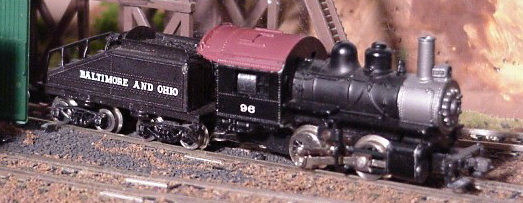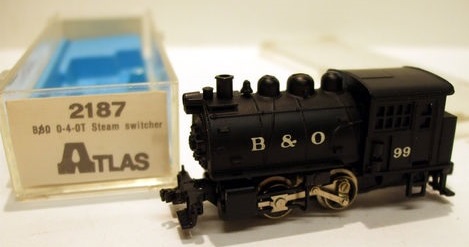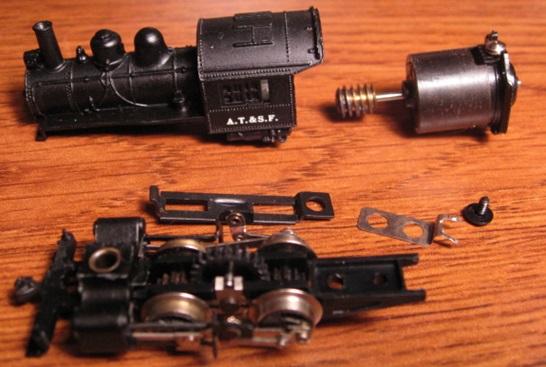

Introduced: 1970 (Atlas import) amd 1977 (Con-Cor import)
Rivarossi manufactured two different 0-4-0's that made use of the same basic chassis/mechanism (the first being an 0-4-0 shifter with tender and the second being an 0-4-0T "Docksider" switcher). Based on the production dates supplied with the models, the shifter with tender was first manufactured starting around 1970. However, they (for whatever reason) didn't start showing up in the US until a couple of years after that. As evidenced by the review below, Model Railroader didn't get their hands on one until 1973. The 0-4-0T story is odder still as they were never sold in the US by Atlas. IE, the B&O docksider pictured below (Atlas catalog #2187) was only available outside the US -

Atlas and Rivarossi eventually went their separate ways, and starting in 1977 Con-Cor became the importer for both of these models. I've never seen them in anything but the old plastic Rivarossi boxes with the blue inserts (either with a "Con-Cor" label inside the box or a sticker slapped on the outside of the box). Neither of these models made it to the Con-Cor "cardboard box with foam insert" era, so I think it's safe to assume that they were both discontinued after their initial production runs were sold and basically vanished sometime in the early-to-mid 1980s. 0-4-0T's are particularly hard to find these days (even the Con-Cor imports), so either their production was very limited or the model itself just wasn't very popular (or both).
Interestingly, Bachmann released their own 0-4-0 shifter locomotive right around the time Rivarossi dropped their's (1985). Some have speculated that there might've been some sort of gentleman's agreement between the two companies to not market competing models of essentially the same prototype.
The "shifter" mechanism is extremely simple and compact. The motor/driveshaft/worm assembly slides into the metal shell from the back and is held in place with four tiny screws. The lower plastic chassis (with the gears and wheels) is held to the shell with three screws (one at the front and two at the back). The motor is the standard Rivarossi 3-pole "can". The worm and the axle gears are metal, whereas the main gear is plastic. Both driver axles are geared (with the running gear just being along for the ride). The forward drivers are equipped with traction tires while the rear drivers provide pickup.

Pickup is also provided by the tender trucks, with one truck picking up one rail and the other truck picking up the other rail. Current is transferred to the engine by way of an interesting 3-piece drawbar arrangement - consisting of two metal drawbar pieces sandwiched around a plastic one. One end is screwed to the tender and the other end is screwed to the locomotive chassis. This arrangement is a great leap forward as compared to previous Rivarossi steam tenders (where pickup only came from one rail and with current being transferred to the motor via a stiff wire on the drawbar). Unfortunately, the tender trucks make use of old-fashioned axle wipers (a notoriously unreliable scheme).
The tender has a truck-mounted Rapido coupler, whereas the pilot has a non-functional knuckle coupler. There is no lighting.
Performance on the shifter version is actually quite good (especially given the model's small size). Pickup is surprisingly effective (even through turnouts), throttle response is smooth and slow-speed creep is pretty good (if unexceptional). As is generally the case with models from the early days, the top-end speed is off the charts. The gear action is smooth (no wobbling or shimmying), and overall the model runs fairly quietly (especially for the early 70s). And although a very light engine, the traction tires should make for decent pulling power. This model has no problems with narrow radius curves. The wheel flanges are enormous, so forget about running these on anything like Code-55 track. I guess the main things to worry about here are the prone-to-meltdown Rivarossi motors and the unreliable axle wipers on the tender trucks. But overall, the shifters are decent runners.
As mentioned above, the 0-4-0T makes use of the exact same mechanism as the shifter (with the obvious differences in the shell along with the lack of a tender). Not surprisingly, there are no traction tires on the "T" (this thing needing all the pickup it can get). Unfortunately, the lack of traction tires no doubt reduces pulling power significantly. And even without the traction tires, pickup is not really sufficient to allow these things to make it through turnouts at slow speeds (not turnouts with non-powered frogs anyway). So overall, not a particularly useful locomotive.
Trivia - Back in the 1970s, a Detroit-area company called "Flint Models" produced brass shells for the Atlas/Riv C-Liner, 0-4-0, 0-8-0 and 4-6-2 models, along with Arnold's 0-6-0. Generally speaking, the original concept was to improve traction/operation, what with the added weight allowing the engine to pull more and maintain better electrical contact - which seems a bit odd here, since these models already had metal locomotive shells. Maybe Flint just figured there was a market for people who liked pretty brass shells -

Grade: B (for the 0-4-0 shifter) and C (for the 0-4-0T)
Reviewed: 5/73 Model Railroader ("The Atlas N scale model follows the proportions of the prototype. The engine and tender bodies are well-detailed plastic castings with a lot of fine rivet detail and cast-on fittings. Engine and tender frames are zinc alloy castings. The scale 44" drivers have nickle silver rims and cast plastic centers. The 33" tender wheels are nickle silver with one side insulated for two-rail operation. The flanges are .031" deep and the check gauge is .310". Both front drivers are fitted with friction treads... An unusual combination of wheels is used in the current collection system. The current from one rail is picked up through one driver and one tender truck. The second tender truck picks up from the opposite rail... The plastic drawbar has metal connectors on top and bottom to carry current... A small can-type motor completely fills the cab... There are no side rods but the main rods are bulky enough to cover this unless the model is examined closely. The valve gear simulates the Walschaert type used on the prototype... Our test sample ran smoothly after lubrication... the minimum scale speed is higher than desired... Our test hauled 10 average freight cars... This is a neat model. As delivered, it is painted black with a silver smokebox and a red oxide cab roof. Decals are included for GN, UP, SF, SP, PRR, Reading, NKP, and B&O. Price: $15")